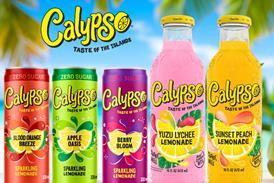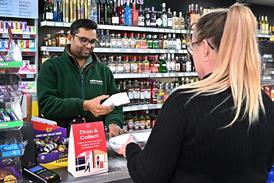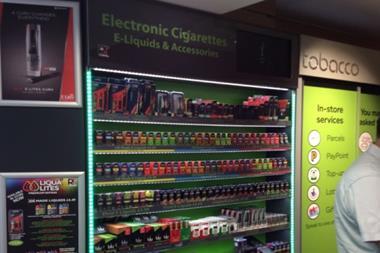With sales thought to have doubled in the past two years, e-cigs and other vaping products offer a significant profit opportunity for stores
From small countertop display units to flashy dedicated gantries, it’s fair to say that most UK convenience stores are investing in the booming electronic cigarette (e-cig) and vaping products market in one way or another. And with an estimated value of £126.8m, according to E-Lites owner JTI, you can see why.
The market’s value is thought to have doubled over the past two years with about 1.5m million existing and former adult smokers now using e-cigs, which are thought to be less harmful than tobacco as well as more affordable and socially acceptable. Little surprise, then, that JTI’s head of communications Jeremy Blackburn describes them as a “significant profit opportunity for retailers”.
Charlotte McGaughey, brand manager for the BAT-owned Vype brand, agrees. “Among the UK adult smoking population about 56% have tried an e-cig, which means there’s great awareness of the category among adult shoppers, but still further headroom for growth.”
While e-cigs and other vaping devices such as nicotine-free e-shisha products can be bought from a wide variety of outlets such as specialist shops, chemists, market stalls and online, most sales take place via grocery stores, McGaughey says.
“Grocery is the largest retail channel with 55% of the market, but the share of convenience stores has been steadily growing, making up 30%. This is due in part to the increase in open system formats and the impulse and top-up nature of the product, which make the channel vital to continued category growth,” she adds.
Category growth is being driven by many different factors. Health is one, along with affordability. Asked why they used e-cigs, almost 80% of vapers said they did so to help cut down on the number of tobacco cigarettes they smoked, as Evidence Update on e-cigs by government body Public Health England (PHE) recently revealed.
In the report, just over 65% said they used them because they were cheaper than tobacco cigarettes; 61% said that they used them to get around laws on smoking in public places; while 16% said they used them because they had been advised to by a public health professional.
There is little doubt that recent positive reports are also helping to boost confidence in the sector. The PHE report concluded that “e-cigs are significantly less harmful to health than tobacco and have the potential to help smokers quit smoking”.
Key findings included: e-cigs are about 95% less harmful than smoking; and that there is no evidence so far that e-cigs act as a route into smoking for children or non-smokers.
The constant development of e-cig flavours is another factor in the sector’s growth, JTI’s Blackburn adds. “Vapers tend to switch between a wide variety of flavours rather than sticking to one,” he points out.
At the moment, the E-Lites Original range is available only in regular, light and menthol flavours, but Blackburn intriguingly advises retailers to “watch this space”.
Salesforce support and national marketing campaigns from some of the UK’s biggest brands, including E-Lites, are also helping to raise awareness of the category, he says.
“New product development is a driver and we’ve certainly been at the forefront of that with the launch of new E-Lites Curv,” Blackburn adds.
Launched earlier this year with the support of a high-profile TV campaign and media partnership with the Metro newspaper, E-Lites Curv was brought to life with insight gained from analysis of the strongest-performing SKUs in the existing E-Lites Original range. With its light weight, unique oval shape and convenient 2.5 hour charge time, Curv has been designed “to deliver a superior and convenient vaping experience with extra reassurance on e-liquid quality,” Blackburn adds.
Retailers’ growing thirst for knowledge is also helping to better educate new and existing vapers about the category, which in turn is helping to boost sales and interest in pricier, more advanced models and variants.
Store owners such as Paul Cheema of Malcom’s in Coventry are taking strides to better communicate the category, and all of its intricacies and possibilities to shoppers. Paul, whose store now features a dedicated e-cig and other vaping products gantry, says: “I spend a lot of time educating myself about the category and talking to manufacturers and companies such as Vivid, Litejoy and Real Trading to be sure that I have the knowledge and insight to talk to customers confidently about the category.”
The store holds regular e-cig drop-in and education sessions with key manufacturers on Friday nights, which Paul says are proving to be a “roaring success”.
“Over the past few months we’ve developed from a convenience store that sold a few e-cigs to a convenience store and vaping products specialist, and the response from local people has been amazing. It’s about selling them the whole e-cig experience, not just the product,” Paul says.
This type of positive engagement is key to future growth, Vype’s McGaughey points out. “Convenience is a key channel for this category as it allows greater dialogue with adult shoppers, and opportunities for impulse and on-the-go purchase. One of the biggest barriers to adoption is not understanding the products. Retailers can help by being knowledgeable and setting out a space dedicated to the category.”
So just who are these e-cig smokers? The PHE’s 2015 Evidence Update describes e-cig users as almost exclusively smokers (60%) or ex-smokers (40%) - that is, smokers who now use e-cigs and have stopped smoking altogether.
Use of e-cigs among people who have never smoked tobacco is very low, estimated to be 0.2%.
Regular use of e-cigs among young people is also rare, with about 2% of young people who already smoke tobacco thought to be using them monthly and 0.5% weekly. E-cig use among young people who have never smoked stands at less than 0.3%.
While earlier surveys suggested that there was a social gradient in the use of e-cigs, with smokers of higher income and education being more likely to have used and tried them, the 2015 ASH Smokefree GB adult 2015 survey indicated only small differences across groups, with lower socio-economic groups slightly more likely to have tried or to be using e-cigs.
Where to start
If you’re relatively new to the e-cigs and vaping products category, what should a basic entry-level offer look like? All the major manufacturers and successful retailers agree that at the very least it should include a mix of disposable instant-use products along with full-kit rechargeable products to satisfy both first-time and repeat purchasers
On top of this, stocking the right brands will also drive sales, Blu category and shopper marketing controller Jennifer Roberts says. She claims that almost 30% of consumers will shop elsewhere if their first-choice e-cig brand is not available. She recommends making sure you’re stocking at least two or three of the top five brands in the convenience channel, which include Blu, E-Lites, Nicolites, Vivid and MV.
But where to display them? Danny Sohota from Real Trading, which distributes multiple e-cig and vaping brands to convenience stores, has a few pointers. For retailers new to the e-cig category and small c-stores he advises keeping e-cigs on the counter “and if this is not possible, place them next to the cigarette gantry or, in England, Wales and Northern Ireland, in the sundries unit where they can clearly be seen”.
However, he warns retailers to beware of “counter overload” from having too many on-counter stands.
A number of retailers supplied by Real Trading have installed bespoke solutions, some even replacing the cigarette gantry.
Paul Hunt, UK managing director of V2 Cigs, thinks the tobacco display ban has given retailers a golden opportunity to focus their behind-the-counter displays on e-cigs and other vaping products.
“E-cigs offer cost savings and good margins for retailers when compared with traditional cigarettes, and retailers should therefore look to ensure that their point of sale is located within easy view of the consumer to engage and educate them on vaping,” he says.
Vype’s McGaughey agrees: “Shopper marketing at the point of purchase gives us the opportunity to talk to adult shoppers directly about the e-cig category,” she says.
Romi Mediratta, of Lane End Londis, High Wycombe, Buckinghamshire, has seen success from moving his e-cigs from the counter to the area behind the counter. “I now stock three different brands of e-cigs across the three main categories. I have made space for them on the back wall where batteries and razor blades used to be,” he says. “I have spent quite a bit of time educating myself about the category as I get asked so many questions by shoppers. One of the most common from tobacco smokers who are looking to switch to e-cigs is: ‘Which type is most similar to my favourite tobacco brand?’ It’s important that I know all the different strengths and flavour options to give them the right product for their tastes and needs.”
The law and you
The e-cigs and other vaping products category will receive its fair share of regulation in the year ahead. The tide started with a new law banning the sale of e-cigs to under-18s on 1 October and outlawed proxy purchasing of e-cigs and vaping devices to under-18s.
From May 2016 the revised EU Tobacco Products Directive will introduce new regulations for all e-cigs and refill containers which do not have a medical licence from the MHRA. This will affect most products for sale in the UK as there are currently no e-cigs licensed as medicines on the UK market.
The regulations will introduce a cap of 20mg/ml on nicotine concentrations, taking some high-nicotine e-cigs and refill liquids off the shelves entirely.
E-cigs and vaping devices will also have to comply with new safety measures to ensure they are child- and tamper-proof and protected against leakage.
Only ingredients of high purity may be used in the nicotine-containing liquid, and e-cigs will be required to deliver the nicotine doses at consistent levels under normal conditions of use. This means that a similar level of nicotine should be delivered each time an e-cigarette is puffed for the same amount of time and with the same strength.
The industry has already had to adjust to new advertising rules which came into effect last November. TV adverts must now avoid containing anything that promotes the use of a tobacco product, or that shows the use of a tobacco product in a positive light.
In addition, people shown using e-cigs or playing a significant role must neither be, nor seem to be, under the age of 25. They must also not encourage non-smokers or non-nicotine users to use e-cigs.
Imperial Tobacco-owned Blu was ahead of the curve when the new regulations on advertising were introduced as its self-imposed standards meant that it was already fully compliant. As Roberts explains: “Blu UK’s standards require that we do not advertise on TV before 9pm, position billboards within 150m of schools, or place advertising in any printed publication unless at least 85% of readers are over the age of 18.”
vital statistics
How the market shapes up
The vaping products market can be divided into three segments: disposable entry-level products for first-time or on-the-go use; rechargeable products; and open systems which include tanks and e-liquids for more experienced vapers.
According to Nielsen Market Track data from JTI, which excludes online sales, the rechargeable sector is now the largest in terms of retail sales value, worth an estimated £88.1m.
Disposables are in second place, but with a much lower value at £21.5m. Tanks (used to contain e-liquids) are the smallest segment of the market worth £14.7m, but this sector is currently experiencing rip-roaring growth. In fact, according to data from Vype - which launched a new eTank starter kit and eLiquids range in July - this year open systems have grown to account for 34% of the market, up from 14% this time last year.
Vype’s range includes nine flavours and three different nicotine strengths, allowing vapers to create a variety of different recipes for their device.
Trends
Innovation set to keep consumers interested
With the technology of e-cigs and other vaping products evolving, expect a great deal of new product development (NPD) in the category, predicts JTI’s head of communications Jeremy Blackburn.
“As consumer knowledge and understanding of e-cigarette products available increases, it will be more important than ever for manufacturers to match NPD to purchasing trends,” says Blackburn.
Developments are likely to focus on tank systems, which are becoming increasingly popular. Aware of the growth opportunity that the tank sector (growing at 14% year on year) represents, JTI has already begun to invest in the future of the category with the recent acquisition of Logic, the leading independent US e-cigarette company which owns the Logic Pro tank system.
Tanks are already big news at Paul Cheema’s Malcom’s store in Coventry.The store stocks a wide range of different vaping devices and components and has recently added a range of tanks.
“The tanks appeal to real vaping enthusiasts and they retail for between £49 and £150! It’s great news for us as the margins on them are great and also these bigger tanks burn e-liquids quicker, which means we sell even more,” Paul says.
Nicocigs unveils next-generation Vivid
As e-liquid vaping products continue to grow in popularity, Vivid has introduced its next-generation format for improved vaping performance and greater convenience.
The e-liquid brand from Philip Morris International is investing significantly in its new Vivid e-liquid capsule vaping product with a £3m spend to drive both trade and consumer awareness.
Marketing support will include point-of-sale units, in-store promotions and starter kit discount vouchers.
Vivid will also be the subject of a marketing campaign including sampling at festivals and events, as well as PR support.
“We know that people want a vaping product with better performance and improved convenience, which are the key benefits of the new Vivid,” says Nicocigs managing director Nikhil Nathwani. “The result is a system that gives more vapour by using next-generation technology, a convenient no-spill capsule delivery and a premium range of flavours, so the vaping experience is more Vivid.”
The brand has an enhanced single coil that produces greater vapour. Its convenient click and connect technology means that only Vivid e-liquid capsules are compatible and no filling is required, which eliminates any risk of leaking. The system, which requires users to buy Vivid capsules for refills, will result in greater consumer loyalty and improved profits for stockists, Nathwani adds. It is available in 10 liquid flavours: Berry Blast; Fruit Fusion; Apricot Peach; Pineapple Rocks; Cinnamon Apple; Red Wings; Menthol Breeze; Citrus Fruit; Classic Tobacco; and Golden Tobacco.




























No comments yet